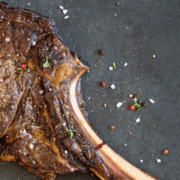When sculpting a strong and resilient physique, free weight training has stood the test of time as an effective and versatile approach. Among the various available options, one technique that has gained popularity in recent years is the concept of “metallic muscles.”
This approach combines traditional barbells and other free weights with modern exercise science principles to help individuals achieve their fitness goals. This article will delve into the world of metallic muscles and explore how mastering the art of free weight training can lead to remarkable physical transformations.
Contents
The Foundation Of Free Weight Training
Free weight training involves exercises performed with dumbbells, barbells, kettlebells, and other weight equipment that are not fixed to a machine. Unlike machine-based exercises, which guide your movement through a predetermined path, free weights engage a range of stabilizing muscles as you control the weight’s motion.
This activation of stabilizers not only improves strength but also enhances balance and coordination. In general terms, weight training refers to an organized exercise where the bodily muscles are forced to contract using weights and body weights to stimulate power, strength, and endurance. The basis of success in weight training is usually combined by several factors.
Mechanisms Of Muscle Growth
It’s important to grasp the mechanisms of muscle growth to understand the concept of metallic muscles. When you subject your muscles to resistance, such as lifting weights, you create micro-tears in the muscle fibers. In response, the body repairs these tears and reinforces the muscle tissue, increasing growth and strength.
This adaptation process is the cornerstone of metallic muscles. When it comes to muscle growth, there are three key mechanisms: metabolic stress, muscle damage, and muscle tension. Usually, these factors have an interrelationship with the weight amount you are lifting. However, you only have to compare bodybuilders and powerlifters to identify if that’s the case.
Muscle growth at the time of hypertrophy gets controlled and assessed at the translational phase. mTORC1 plays a key role in regulating both ribosomal biogenesis and protein synthesis.
The Art Of Consistent Overload
Central to achieving metallic muscles is the principle of progressive weight. In this procedure, one might have to gradually maximize the resistance put on the muscles. As time passes by, they have to keep challenging their muscles with increasing weights and more challenging variations of exercises, which stimulate ongoing growth and improvement.
The principle of overload depicts that to improve and progress, you must put the body under tremendous stress beyond the average weight. Overload helps in enhancing the aspect of the body that should continuously increase the demands put on the proper body systems.
Balancing Intensity And Technique
While the concept of metallic muscles emphasizes pushing your limits, it’s crucial not to overlook the importance of proper technique. Sacrificing form for the sake of heavier weights can lead to injuries and hinder progress. Finding the right balance between intensity and technique is key to unlocking the full potential of free weight training.
Balance intensity means the degree of challenge that balances the control system of your body to the capacity of maintaining balance. On the other hand, high balance intensity is the highest balance-enhancing exercise level. These can be tackled without including a trip or a fall.
The scale to measure Balance Intensity has been designed to be used to balance exercise. It measures how difficult an exerciser is to find balanced tasks and if they can use it for initial assessments. In order to use this scale, the exercise is first checked, and later, the exercise is performed.
Customizing Your Metallic Muscles Routine
One of the beauties of metallic muscle training lies in its flexibility. Whether you aim for a bodybuilder’s physique, enhanced athletic performance, or improved overall fitness, you can tailor your routine accordingly. For hypertrophy (muscle growth), focus on lifting challenging weights but allow you to perform around 8-12 reps per set.
For strength gains, opt for heavier weights with lower reps, typically 4-6 reps per set. Experiment with exercises, rep ranges, and rest periods to find what works best. A lot of people also tend to rely on dynamic weight for resistance training. They not only help the body to get stronger but also enhance body composition.
Fueling Your Metallic Muscles Journey
Proper nutrition is the fuel that propels your metallic muscles to journey forward. To support muscle growth and recovery, ensure an adequate intake of protein. Poultry, lean meats, dairy, fish, plant-based protein sources, and legumes should be integral parts of your diet. Complex carbohydrates provide sustained energy for intense workouts, while healthy fats contribute to overall health and hormone balance.
In general terms, progressive overload training is a better alternative for you. But refrain from adding too much weight that simply sores your muscle or results in potential injury. The idea is to stay fit and in shape without ruining your body parts.
Rest And Healing
In pursuing metallic muscles, remember that progress is not solely made in the gym. Adequate rest as well as recovery are just as essential. Not only do the muscles grow, but they also repair when you get ample rest, so get enough sleep and allow your body time to heal between intense training sessions.
Training is a rigorous act that needs tremendous rest. Without proper rest, your body becomes vulnerable to several illnesses. And you would definitely not want to fall sick in such a critical situation. Just like you dedicate time for strenuous training, dedicate ample time for rest as well as healing.
Summing It All…
In Conclusion, metallic muscles symbolize the fusion of strength, adaptability, and resilience. By embracing the art of free weight training with barbells or dumbbells and integrating modern exercise science principles, individuals can sculpt stronger bodies and a stronger mindset.
Whether you’re a seasoned athlete or a beginner on the fitness journey, exploring the world of metallic muscles can lead to remarkable transformations beyond the gym. So, pick up those weights, embrace the challenge, and embark on a journey to master the art of free weight training.
Read More:














